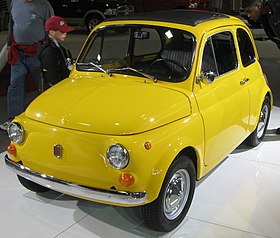
Back فيات 500 Arabic Фиат 500 (1957) Bulgarian Fiat 500 Catalan Fiat 500 Czech Fiat Nuova 500 German Fiat 500 (1957) Greek Fiat 500 Esperanto Fiat 500 (1957) Spanish Fiat 500 Estonian Fiat 500 Basque
| Fiat 500 | |
|---|---|
 1970 Fiat 500 L | |
| Overview | |
| Manufacturer | Fiat |
| Also called | Puch 500 |
| Production | 1957–1975 3,893,294 units[1] |
| Assembly |
|
| Designer | Dante Giacosa |
| Body and chassis | |
| Class | City car (A) |
| Body style |
|
| Layout | Rear-engine, rear-wheel drive |
| Doors |
|
| Related | |
| Powertrain | |
| Engine | |
| Transmission | 4-speed manual |
| Dimensions | |
| Wheelbase |
|
| Length | 2,970 mm (116.9 in) 3,185 mm (125.4 in) (Giardiniera) |
| Width | 1,320 mm (52.0 in) |
| Height | 1,320 mm (52.0 in) |
| Kerb weight | 499 kg (1,100 lb) |
| Chronology | |
| Predecessor | Fiat 500 "Topolino" |
| Successor | |
The Fiat 500 (Italian: Cinquecento, pronounced [ˌtʃiŋkweˈtʃɛnto]) is an economy / city car that was manufactured and marketed by Fiat Automobiles from 1957 until 1975. It was sold as a two-door semi-convertible or saloon car and as a three-door panel van or estate car.
Launched as the Nuova (new) 500 in July 1957,[2] as a successor to the 500 "Topolino", it was an inexpensive and practical small car. Measuring 2.97 metres (9 feet 9 inches) long, and originally powered by a rear-mounted 479 cc two-cylinder, air-cooled engine, the 500 was 24.5 centimetres (9.6 inches) smaller than Fiat's 600, launched two years earlier, and is considered one of the first purpose-designed city cars.[citation needed]
In 1959, Dante Giacosa received a Compasso d'Oro industrial design prize for the Fiat 500. This marked the first time a Compasso d’Oro was awarded to an automotive manufacturer.[3]
- ^ a b c Bouchat, Christian (19 June 2007). "Fifty years since the launch of the Fiat 500 (Part II)". automania.be. Archived from the original on 5 December 2014.
- ^ "Used Car Test: Fiat 500D". Autocar. 818 (130): 49–50. 17 April 1969.
- ^ "Fiat - The people". fcaheritage.com. Retrieved 6 December 2020.